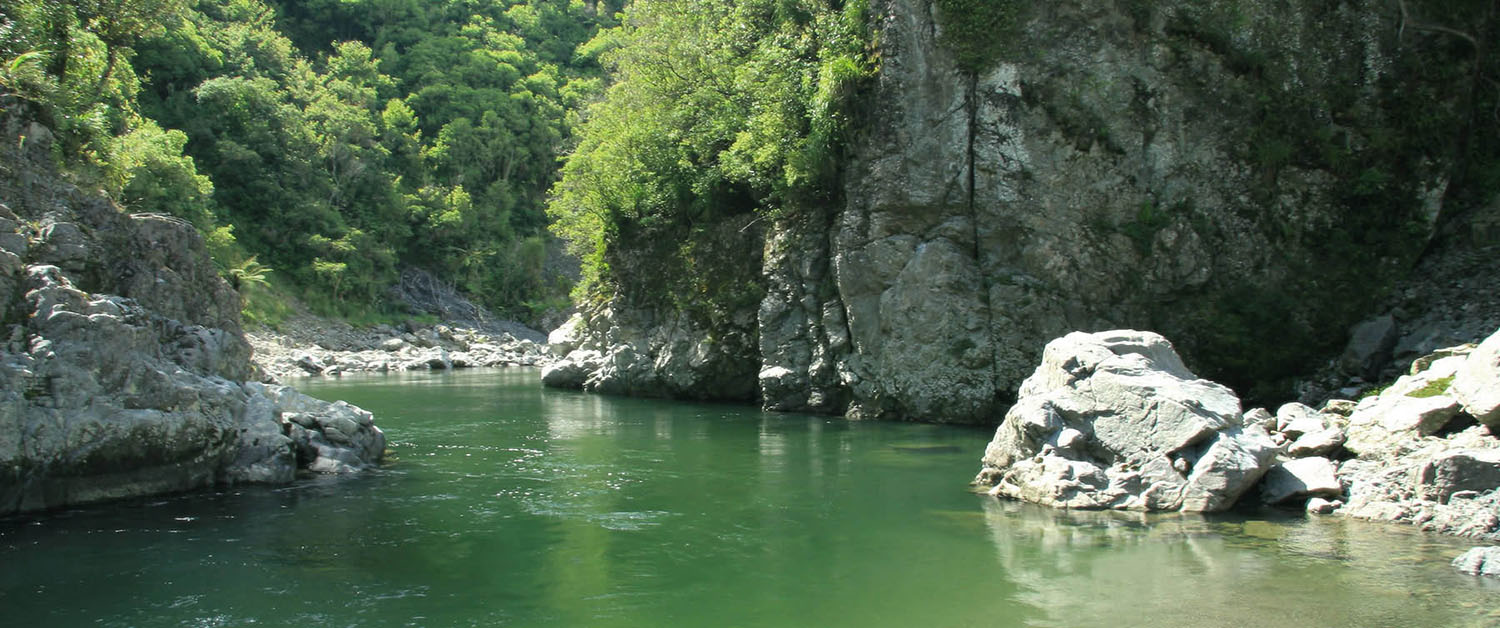Backcountry defined
Backcountry usually refers to isolated or wilderness areas, and in New Zealand there are two main types of backcountry river catchments, called 'rivers' or 'streams' interchangeably. Firstly, those that flow through wide tussock carpeted valleys mostly found on the South Island, and often referred to as ‘high country' rivers or streams. Secondly, those that flow through narrow steep sided valleys of verdant natural bush, deep within mountain ranges on the north and south islands of Aotearoa, New Zealand.
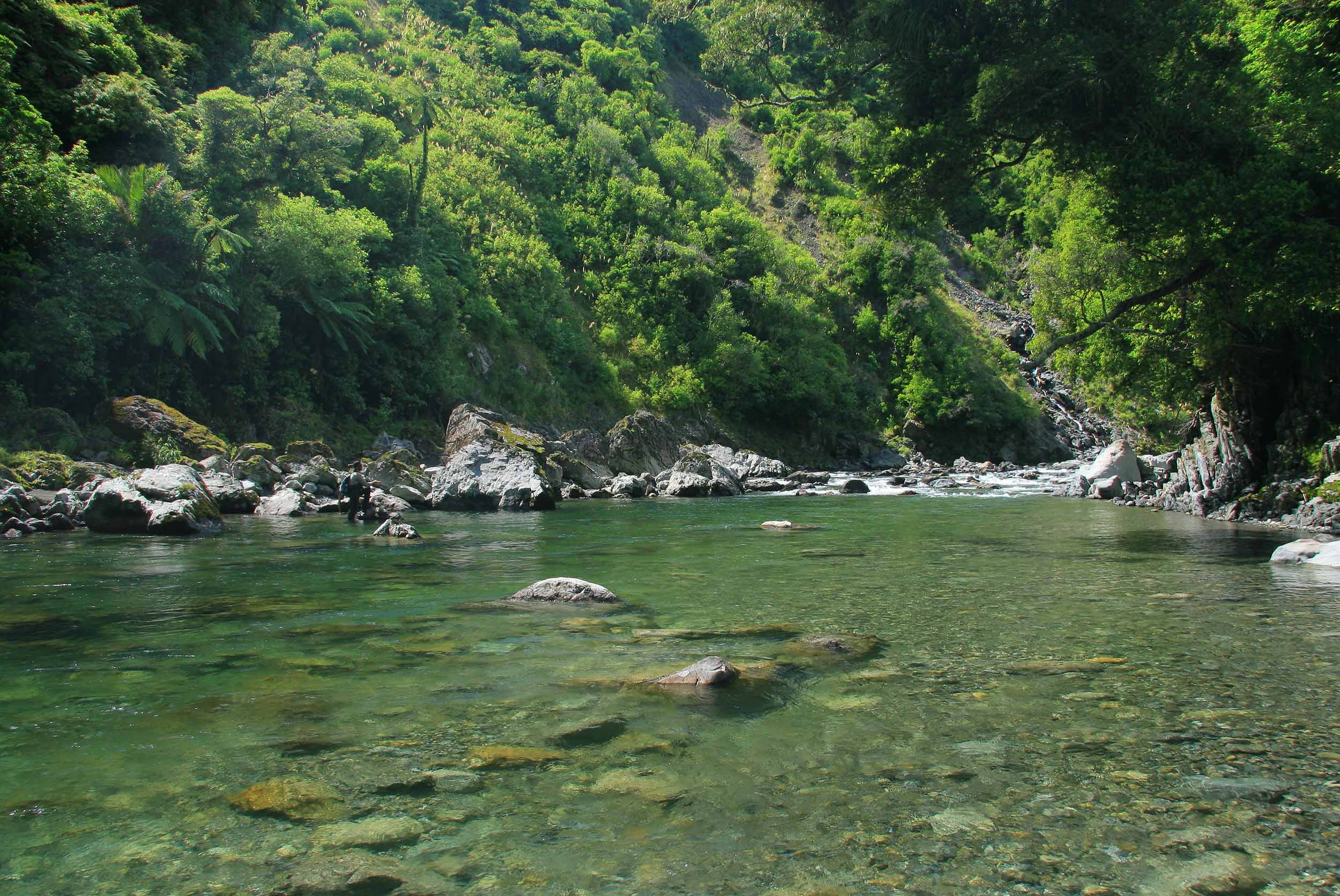
A typical bush 'stream'
New Zealand is blessed with hundreds of bush streams many of which contain trout. While a few are easily accessible, most require a tramp (NZ for ‘hike’) of one to six hours, or alternatively a helicopter ride. Some bush streams are small and intimate while others are large and powerful, but they’re all edgy and wild.
Deep clear pools can flow into white roily rapids, runs and chutes. Progress is made over boulders and logs, often requiring numerous crossings, and sometimes a swim or two and a precarious rock climb to negotiate a deep gorgy pool.
The weather can change in an instant when heavy clouds drift over the skyline and flow rates may rise ten or even a hundredfold in less than half an hour. Although there is no dangerous wildlife, poisonous or toothed, mammoth logs and pieces of driftwood atop rock walls and in the tree-line, way above your head, as well as deep scars here and there, where a strip of mountain side has slipped into the river, serve to remind that one is here at the mercy and grace of nature.
High country rivers are big sky rivers. They flow through wide golden valleys with distant skylines of jagged peaks, sometimes capped with snow. The biggest challenge on these magnificent waters is the Nor-westerly that can howl downstream, making casting and spotting fish difficult.
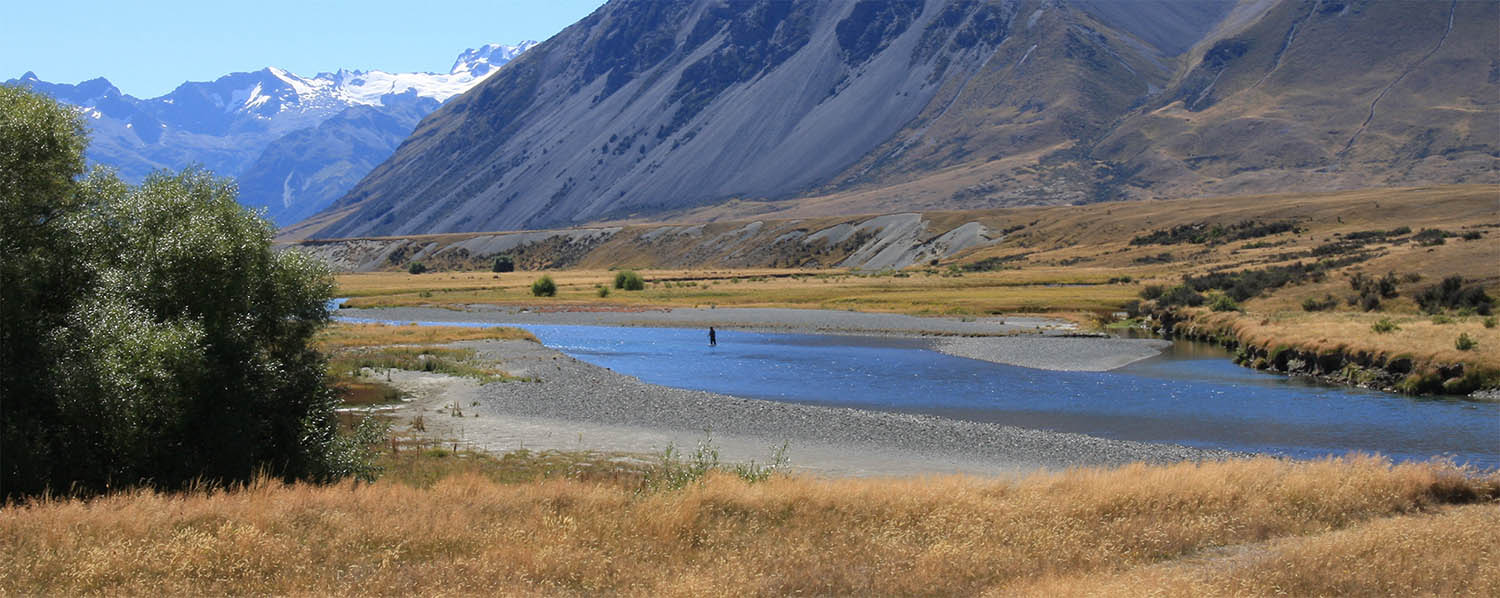
The iconic Ahuriri is a classic high country river
What backcountry streams often have in common, whether of bush or tussock variety, is water as clear as air and large trout. While brown trout are more common, some rivers also contain rainbows, e.g. the upper Rangitikei, Ngaruroro, Ruakituri, Mohaka, Ahiruri and Clinton Rivers.
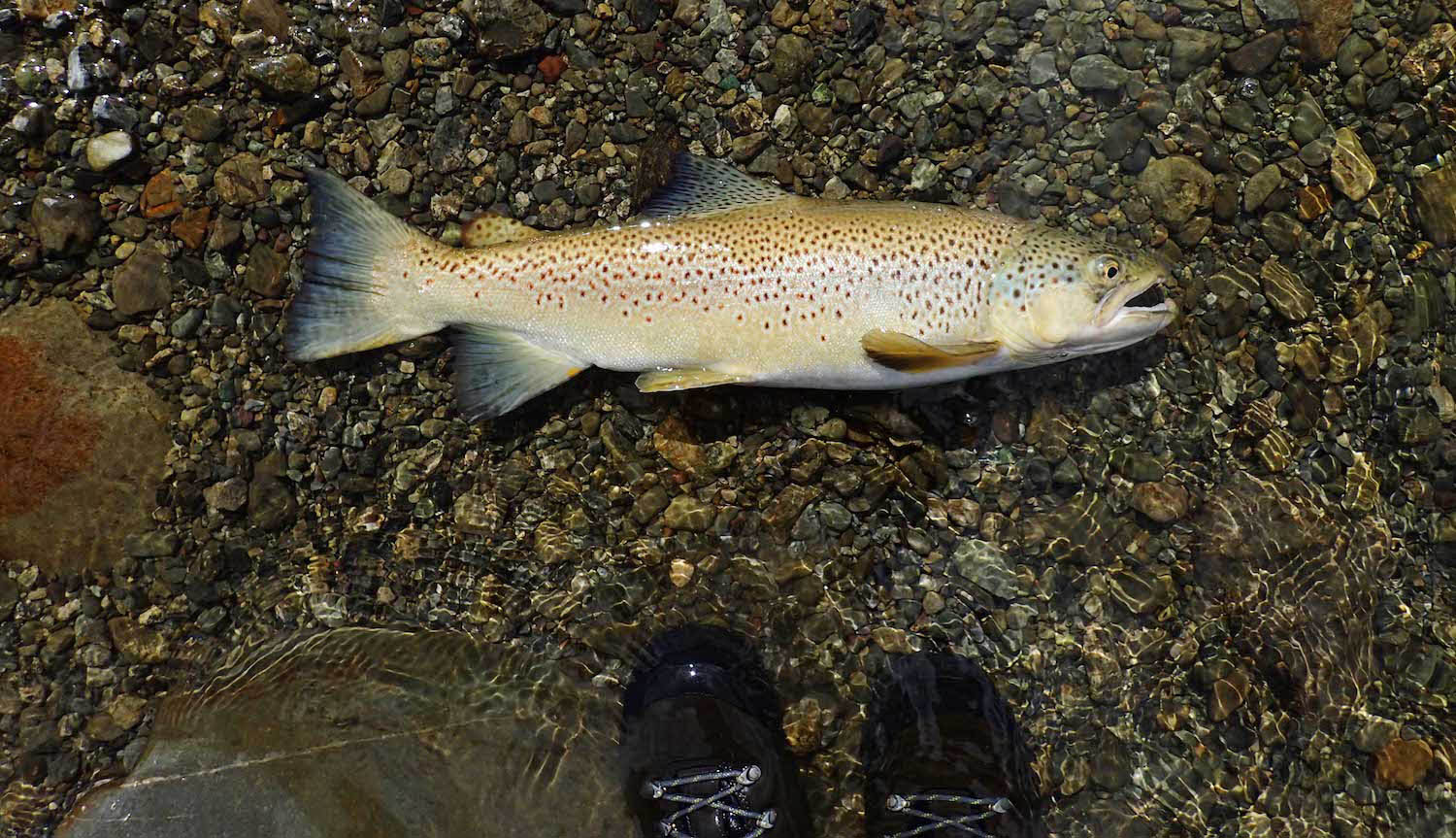
Backcountry trout tend to be large, averaging four to seven pounds, but the numbers of fish are lower than most overseas anglers are used to - generally less than 20 fish per km. On an average day a good angler could expect to land around four fish, lose a couple and miss one or two more. If an angler is after numbers, they may be better off fishing the lowland portions of a river where there are more fish and the gradients more manageable for smaller trout.
At the beginning of the fishing season, in October in New Zealand, some backcountry rivers flowing into lakes are still full of skinny, gullible rainbows that swam upriver and spawned in winter, e.g. the Greenstone, Caples and Hunter Rivers. This article is focussed on wily resident fish, rather than these easy-to-catch post-spawning migrants.
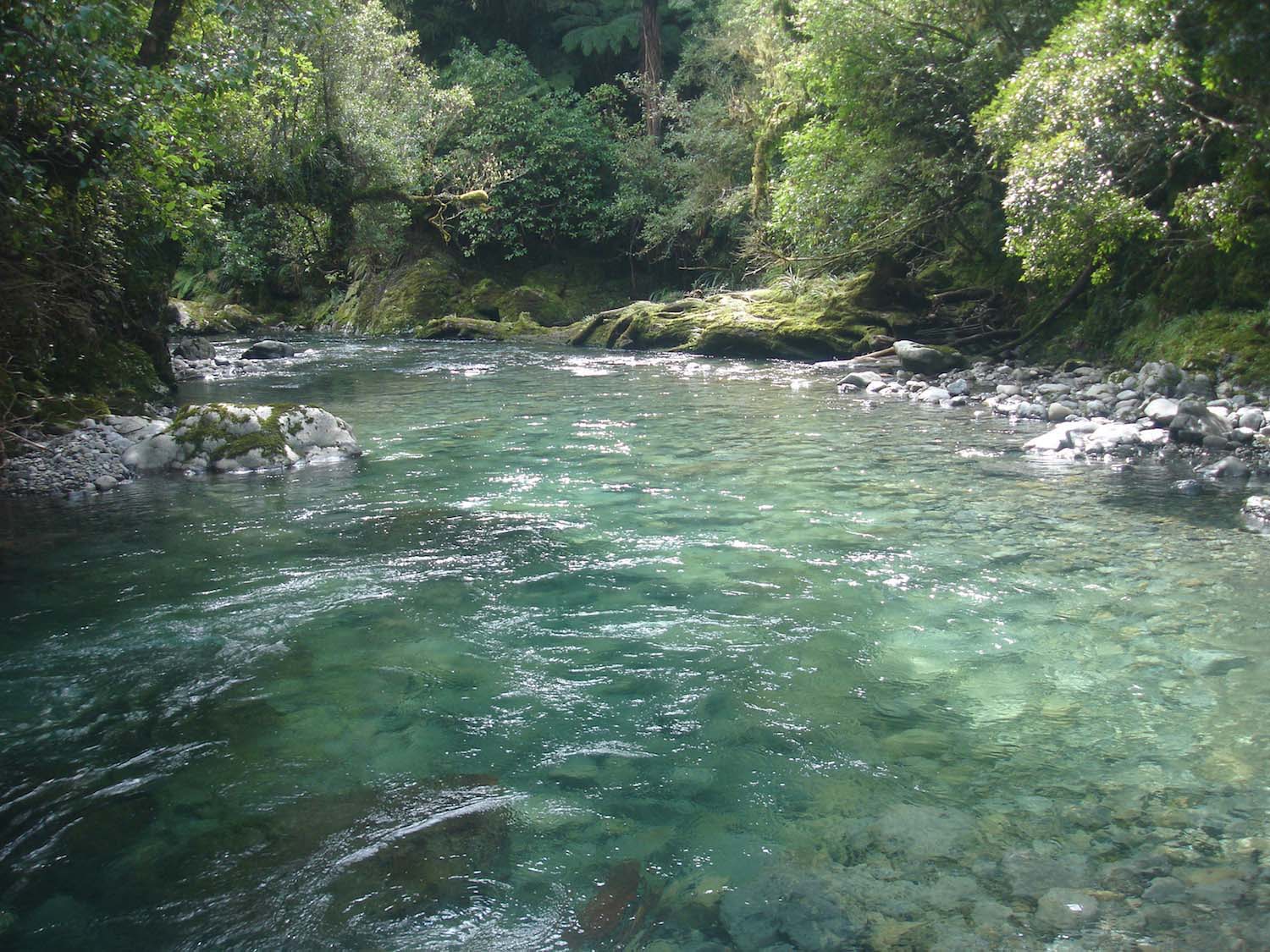
Fishing the Backcountry
The general approach
Targeting sparsely distributed spooky trout in crystal clear water requires special techniques. The most effective approach, outside of the cicada season, is to cast only to sighted fish. This can mean spending most of a day walking and searching for shapes and shadows, so sunny skies are a huge advantage.
Once a fish is spotted, the next step is to cast and present the fly without scaring the fish. Backcountry browns will seldom move more than a foot to intercept a nymph or a small dry fly, so the first cast should be accurate and delicate.
Lines and leaders
Backcountry fly fishing is done predominantly with floating lines. Light coloured floating lines cause line flash when casting, which is believed to be a major cause of spooked trout. Dull olive floating lines are therefore often used by backcountry anglers.
Although colour does play a role when a fly line is on the water. Olive fly lines blend in best with green or shady backgrounds, but against overcast or clear skies are much more visible from below than pale blue lines. Olive fly lines are best for bush steams, while pale blue fly lines with a matt finish are better for high country rivers.
Perhaps more important than the colour of the fly line, is the length of the leader. Fifteen to 18 foot leaders are mandatory for most backcountry conditions, as they allow for delicate presentations and keep the fly line away from spooky fish.
I use Fluorocarbon exclusively for tippets for both nymphs and dry flies. Fluorocarbon under water is supposed to be less visible than nylon, but the reason I use it is that it is much tougher, and I’m broken off less often by large fish.
Though Fluorocarbon is not all made equal - and breaking strain, stretch, suppleness and resistance to shock can vary tremendously between brands.
My favourite product by far is Rio Fluoroflex Plus, it is thin and flexible for Fluoro, doesn’t weaken at the knot with use, and, because it stretches a little, it does not pop on the strike when using dry flies. I tend to use 4x to the dropper and 5x to the point fly, and 5x for dry flies smaller than #12.
Outfits
Five or six weight outfits are ideal. Any lighter and one can experience problems casting large dry flies and heavily weighted nymphs on long leaders into the wind. Heavier, and presentation becomes less delicate than it could be. A modern fast action 9 ft 5 wt fly rod is a much more versatile outfit than those of yesteryear, especially when paired with a modern purpose-made fly line.
Flies and Rigs
Choice of fly depends largely on the time of year. Early in the fishing season, October to November, trout tend to focus on nymphs, but as summer approaches they begin looking to the surface for small terrestrials and hatching mayflies.
For fish more than knee deep and not interested in rising, which can happen early in the season, a Kiwi-style tandem nymph rig is a proven option. This consists of a heavier “dropper” pattern tied directly to the tippet, usually size 14-12 with tungsten bead, and a smaller “point” pattern tethered to the hook bend of the former, via eight to twelve inches of tippet material.
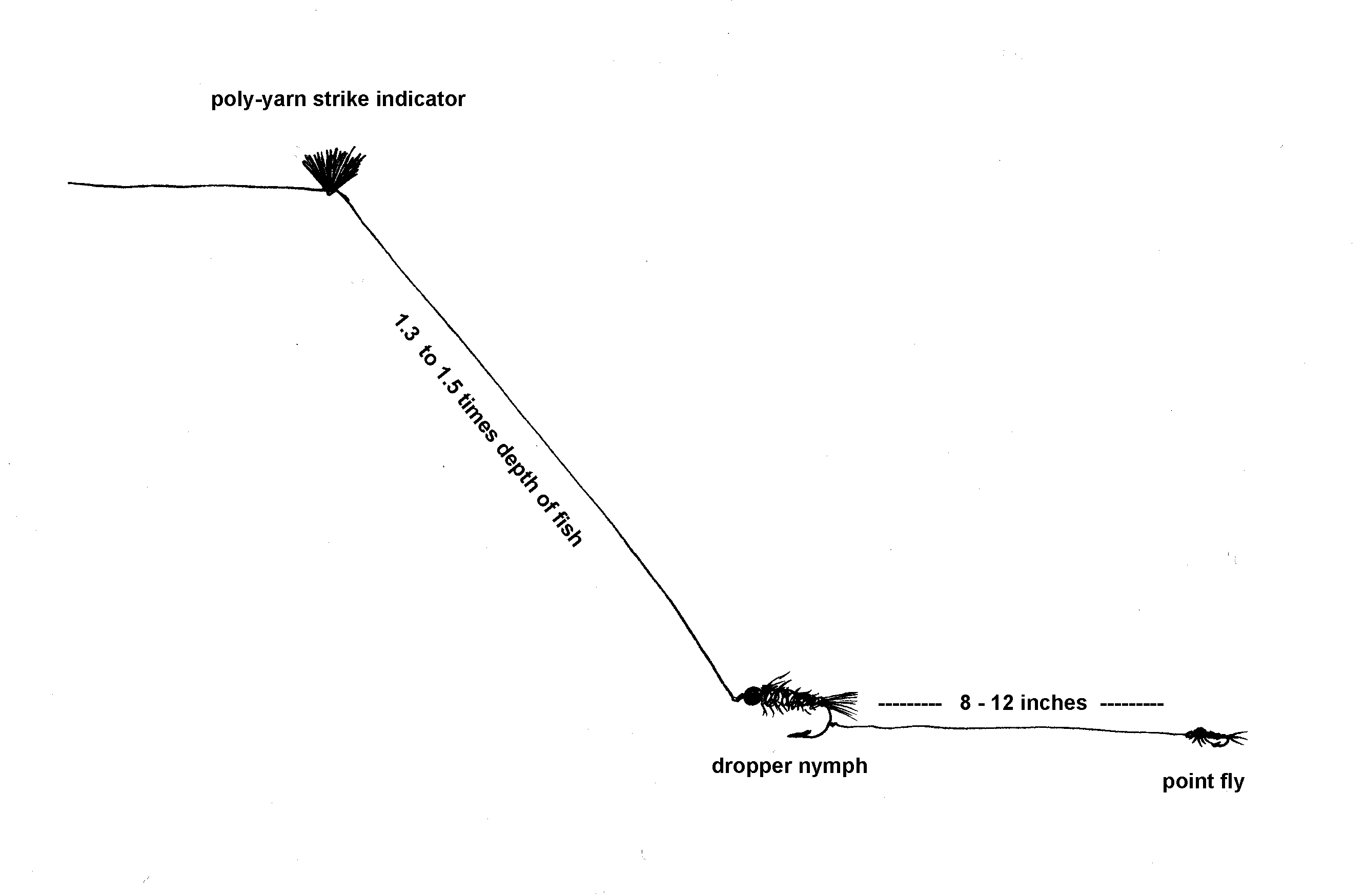
Kiwi-style tandem rig
Although the purpose of the dropper is to provide sufficient weight to achieve the depth needed, it often catches fish if the pattern imitates larger local prey, such as stonefly and swimming mayfly nymphs. Anglers who do not use sufficient weight, tend to spook the target with a volley of accurate but ineffective casts.
As a general guideline, fish in three to four feet of moderately flowing water require dropper patterns with tungsten beads of at least 2.5 or 3mm. The Hares Mask Darter, described in Fly Tying & Design in this website, has proven to be an exceptional fish-catching dropper-design for back country rivers.
Not only is it a good imitation of a swimming mayfly nymph, but the substantial lead underbody and tungsten bead head give it a very good sink rate for its size.
Indicators are an essential part of the sight-fishing tandem nymph rig, not so much to indicate strikes, but to locate the position of the flies and assist with line control to prevent drag. I have many times missed fish by relying only on the indicator, when I should have kept an eye on the fish itself. If, when the indicator is nearby, one sees the trout swerve, or wriggle unusually, or open and close its mouth - strike sharply!
My favourite indicator is a small clump of polypropylene yarn attached with a slip knot to the leader, then treated with paste floatant. Polypropylene is hydrophobic, meaning it does not eventually absorb water the same way that treated globug yarn or sheep’s fleece will. White, cream or light grey indicators look like bubbles or natural flotsam on the water.
Preferably steer away from bright colours for backcountry streams, as in my experience they can spook fish.
The distance between the indicator and the dropper fly should be one-and-a-third to one-and-a-half times the depth of the water being fished. Too short and the indicator will drag under before the flies reach the required depth. Too long and one will miss fish, either because the indicator doesn’t dip under on the take, or because it does not clearly indicate the position of the flies.
Fish holding in shallow margins tend to be the spookiest, so a small lightly-weighted nymph about 1.5 - 2 feet beneath a dry fly is usually the best option. Apart from offering two options, the dry fly also makes for delicate presentation. The nymph is easily attached to the bend of the dry fly hook, creating what is known as a dry fly/nymph tandem rig.
If the trout is near the surface and appears to be ‘looking up’, try a small bushy dry fly, such as a humpy or a mayfly dun imitation, on your first cast. If the fish has a look at the dry fly but does not take, try a fly specifically imitating an abundant local insect you see around you. If there is no response to this dry fly, attach a nymph to it, as described for the dry fly/nymph tandem rig above.
The dry fly/nymph tandem rig is a good first cast option for backcountry streams in summer, when fish are focused on terrestrial insects, and also prepared to rise further for a nymph.
Evidence from research and anecdotal reports, from guides and experienced fishermen, is unequivocal that backcountry trout become more selective after increasing contact with anglers. By mid-summer, point flies as small as size 18 or 20 are often necessary to fool clever fish. Effective patterns are usually those that look like the most abundant aquatic insect at the time.
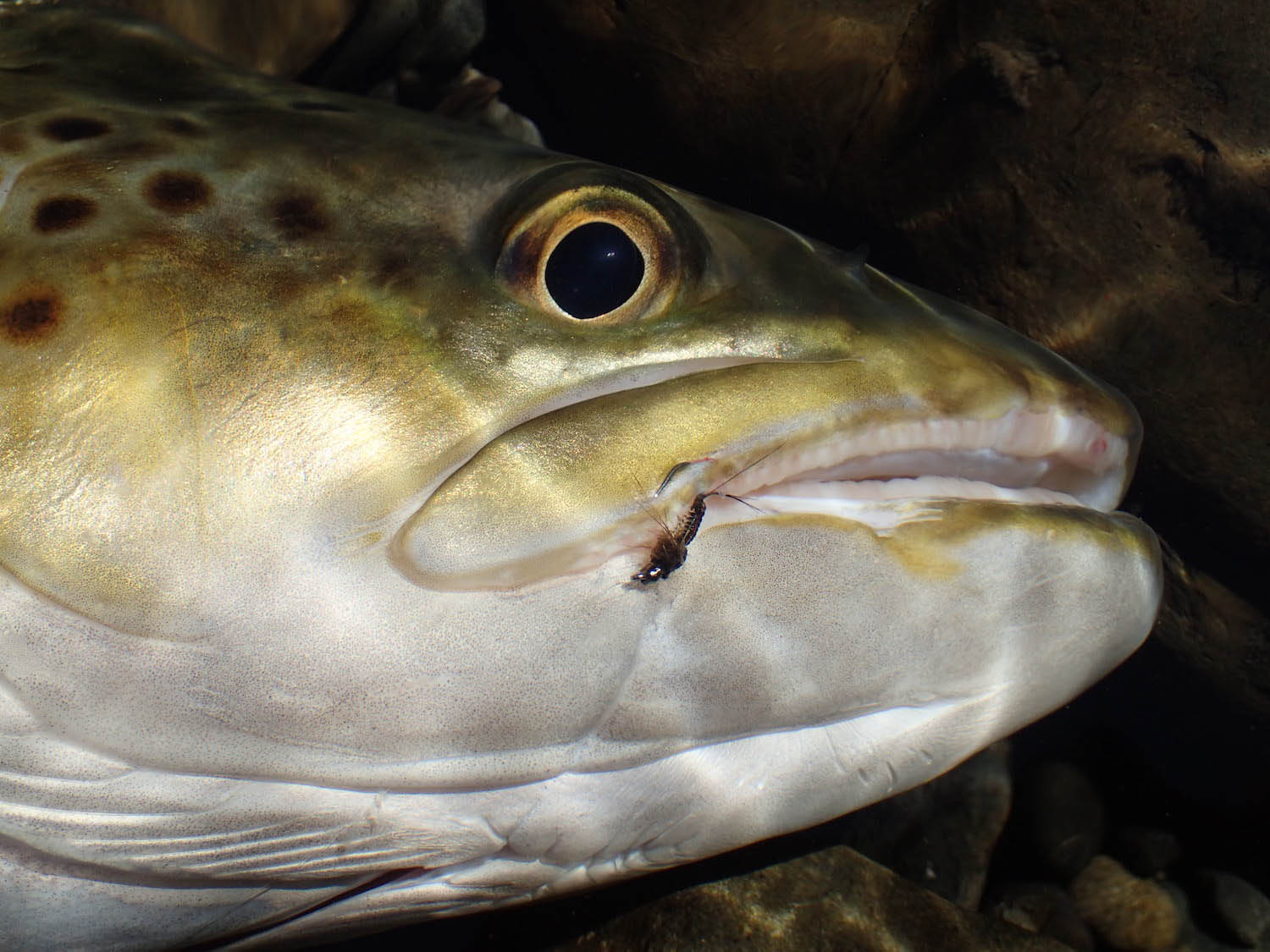
Small nymphs such as this #18 Jelly Crimp Nymph are often necessary to fool smart fish during summer
Presentation, presentation, presentation
The Golden Rule for back country sight fishing is a good first presentation, as the chance of spooking trout in clear shallow water increases with every cast.
Due to the position of a trout’s eyes they have a blind spot immediately behind their tails. An effective tactic is to sneak up on them from directly downstream, then make a short accurate cast that places the leader, but not the fly line, over the fish’s back.
When approaching from behind is not possible, the angler will often need to cast up and across to achieve a natural drift. Since the fish has a greater chance of spotting the angler in this position, an effective strategy is to keep low then false cast behind the trout, to avoid it seeing any line flash, then change the angle of the final delivery so that the fly lands upstream of the trout then drifts onto it.
The distance an angler places a fly upstream of the target is critical - more than about three feet is seldom necessary for dry flies. When nymphing, it’s essential that the flies reach the depth of the fish as they drift past it. If using the direct upstream approach, there is a drift distance equal to the length of the leader minus about three foot - casting any further upstream will surely spook the fish with the fly line.
When casting ‘up and across’ there is usually more distance available. The longer the drift distance the lighter the dropper nymph necessary for a given depth and current speed.
Trout lying in more than about three feet of water are a little less wary than fish in shallow water, and frequently require three or five casts, with the same pattern, before they’ll take. It’s anyone’s guess if this is because trout are focusing on other food items on earlier drifts, or the point fly was not drifting naturally or in an unconvincing position.
Don’t be put off if your first two casts are ignored by a trout that continues feeding, and only change your point fly every five or so drifts.
Feeding fish sway from side to side in the current, whereas spooked fish lie doggo, flat on the bottom, or in severe cases run for cover.
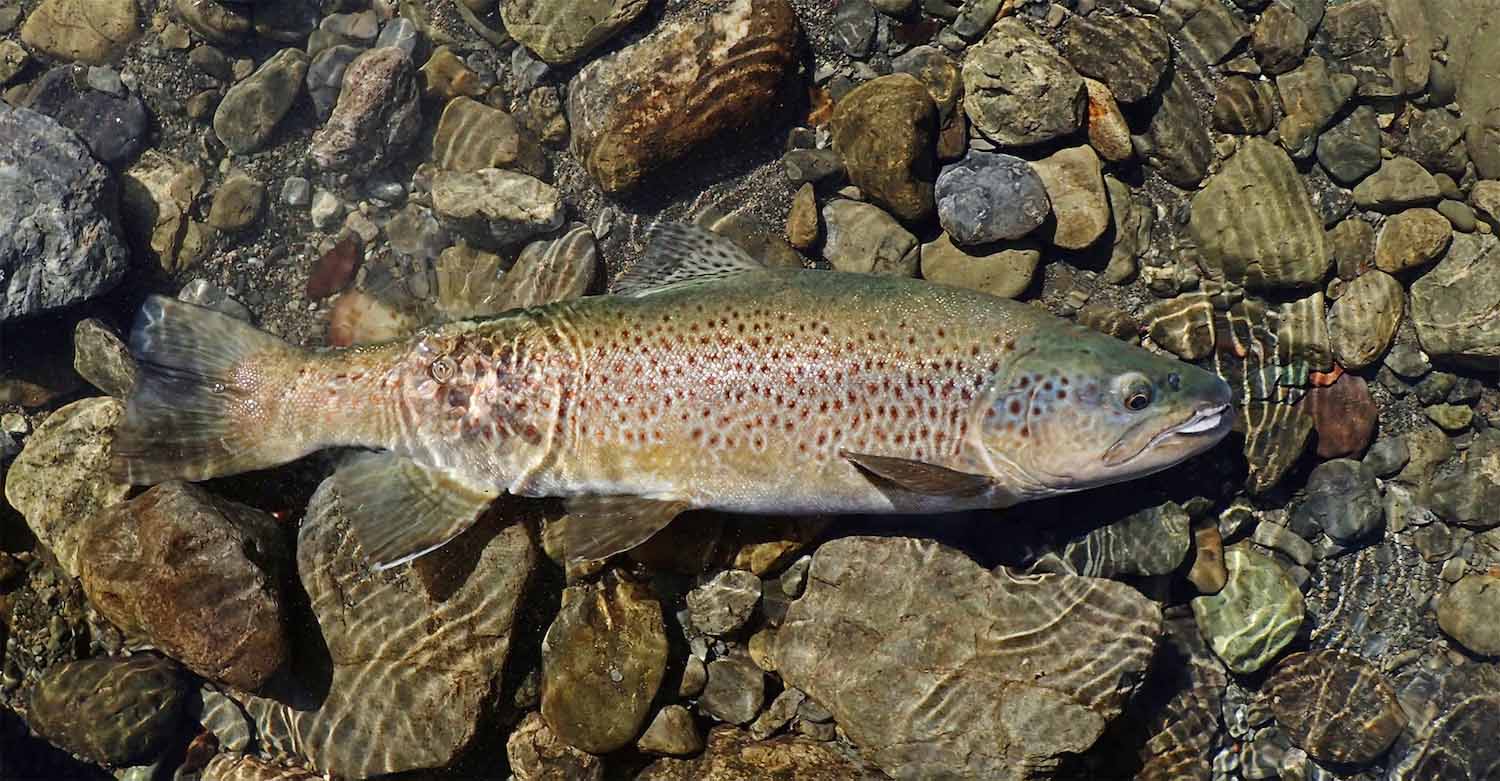
Even small bush streams can hold big fish
Forthcoming Attraction
Backcountry trout are spooky when the season opens on 1 October and become increasingly wily as it progresses, depending on the number of anglers they encounter. Then, around the beginning of February when the fish are close to infuriating in their reluctance, cicadas begin hitting the water, and all that disdainful trout resolve vanishes.
Unseen fish lying hidden amongst the boulders, 4 or even 10 feet below the surface, now happily torpedo all the way to the top to seize one of these big juicy bugs, or something that looks like one.
To read more about making the most of this exciting New Zealand phenomenon, see 'Fishing back country rivers in the cicada season'
